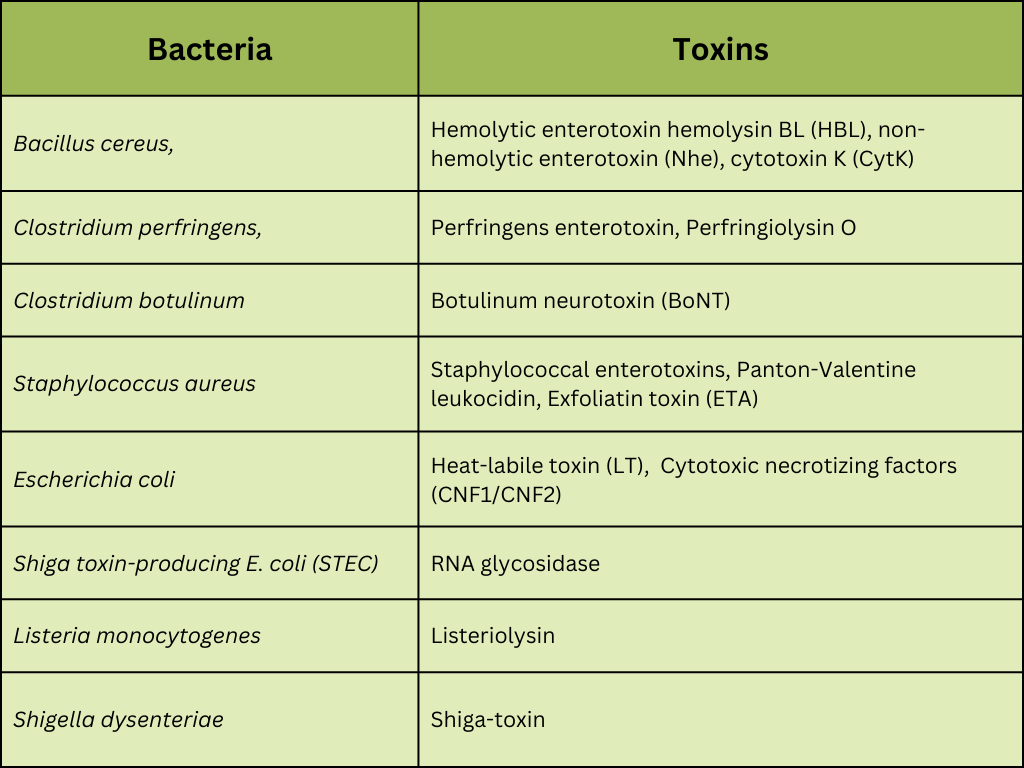Biological Hazards in Food

This post is also available in:
This post is also available in:
![]() Español (Spanish)
Español (Spanish) ![]() Ελληνικά (Greek)
Ελληνικά (Greek)
Which are the biological hazards in food?
Biological hazards occur when hazardous or pathogenic microorganisms and their metabolic products, toxins are introduced to food and thus pose a food safety concern to consumers. Biological hazards include bacteria, viruses, and parasites of public health significance.
Biological hazards in food can originate from environmental sources like soil bacteria and agricultural run-off, as well as from improper sanitation practices and cross-contamination during transportation, handling, processing, and storage. The growth and impact of microorganisms in food are influenced by factors such as the food’s characteristics, the packaging conditions, and the storage environment.
Consuming food that contains harmful microorganisms and their toxins can result in foodborne illnesses. These illnesses can occur as a result of either infection or intoxication or sometimes a combination of both. Infectious microorganisms can harm the host by outcompeting beneficial microorganisms, depleting host resources, and causing damage to host tissues.
Bacteria that can cause Foodborne illnesses
Foodborne bacteria are microorganisms that can contaminate food and cause illness when consumed. These bacteria can be naturally present in the environment (soil, water, air), on the surfaces of raw foods, or introduced through improper handling, processing, or storage practices. The main bacteria associated with foodborne illnesses include:
- Listeria monocytogenes
- Salmonella spp.
- Bacillus cereus
- Campylobacter jejuni
- Clostridium botulinum
- Clostridium perfringens
- Escherichia coli 0157:H7
- Escherichia coli 0104:H4
- Staphylococcus aureus
- Vibrio parahaemolyticus
- Vibrio vulnificus
- Shigella spp.
- Yersinia enterocolitica
- Cronobacter sakazakii
The toxins that are produced by some bacteria are presented below:
Viruses that can cause Foodborne illnesses
Unlike other microorganisms, viruses are composed of distinct segments of DNA or RNA surrounded by a protein coat, and they are unable to survive without a living host. The infectiousness and pathogenicity of viruses vary depending on the specific combination of DNA/RNA and protein coating. Viruses are particularly associated with food safety concerns, can survive in different types of food, and are typically resistant to common food preservation methods.
Viruses are commonly introduced into food either due to improper handling practices by individuals infected with the virus, which includes inadequate personal hygiene practices, or through the presence of contaminated food ingredients, such as contaminated water used during food preparation (e.g. cooking and freezing).
The main viruses associated with foodborne illnesses include:
- Norovirus
- Enteric Virus
- Hepatitis A virus
- Rotavirus
Parasites that can cause Foodborne illnesses
Parasites are organisms that rely on their host organism for growth and reproduction. Typically they do not provide any benefits and can be harmful to the host. Parasites are often involved in causing foodborne illnesses.
- Toxoplasma gondii
- Trichinella spiralis
- Cryptosporidium parvum
- Giardia sp.
- Taenia spp.
Other biological hazards
Prions are another type of biological hazard that can pose risks to food safety. These infectious agents, which are proteinaceous infectious particles, are responsible for causing various diseases in both humans and animals. One well-known example is BSE, commonly referred to as “Mad Cow Disease,” which affects the nervous system of cattle and is a progressive and fatal condition. BSE is classified as a transmissible spongiform encephalopathy (TSE). Other TSEs include scrapie in sheep and chronic wasting disease in deer and elk. In humans, consuming BSE-infected cattle is believed to be linked to Creutzfeldt-Jakob disease. The presence of prions is associated with BSE, although the exact cause of the disease remains unknown.
Which are the food safety hazards?
Physical Hazards in food
References,
ESFA, Chemical contaminants in food and feed
Government of Canada, Chapter 4: Food Safety Hazards
Antonella Cianferoni, Jonathan M Spergel, Food Allergy: Review, Classification and Diagnosis, Allergology International, Volume 58, Issue 4, 2009, Pages 457-466, ISSN 1323-8930, https://doi.org/10.2332/allergolint.09-RAI-0138.
Food Standards Agency, Government of UK, Allergen guidance for food businesses
Government of Canada, Province of Manitoba, Physical Hazards in Food
Iweala OI, Choudhary SK, Commins SP. Food Allergy. Curr Gastroenterol Rep. 2018 Apr 5;20(5):17. doi: 10.1007/s11894-018-0624-y. PMID: 29623490; PMCID: PMC5940350.
Harvard Medical School, 2021, Common food additives and chemicals harmful to children
Jain A, Mathur P. Evaluating Hazards Posed by Additives in Food- A Review of Studies Adopting A Risk Assessment Approach. Curr Res Nutr Food Sci 2015;3(3). http://dx.doi.org/10.12944/CRNFSJ.3.3.08
University of Nebraska, Institute of Agriculture and Natural Resources, Food Allergy research and resource program
Forbes JD. Clinically Important Toxins in Bacterial Infection: Utility of Laboratory Detection. Clin Microbiol Newsl. 2020 Oct 15;42(20):163-170. doi: 10.1016/j.clinmicnews.2020.09.003. Epub 2020 Oct 7. PMID: 33046946; PMCID: PMC7541054.
Senesi S, Ghelardi E. Production, secretion and biological activity of Bacillus cereus enterotoxins. Toxins (Basel). 2010 Jul;2(7):1690-703. doi: 10.3390/toxins2071690. Epub 2010 Jun 29. PMID: 22069656; PMCID: PMC3153264.
Rather IA, Koh WY, Paek WK, Lim J. The Sources of Chemical Contaminants in Food and Their Health Implications. Front Pharmacol. 2017 Nov 17;8:830. doi: 10.3389/fphar.2017.00830. PMID: 29204118; PMCID: PMC5699236.
Ssemugabo C, Bradman A, Ssempebwa JC, Sillé F, Guwatudde D. Pesticide Residues in Fresh Fruit and Vegetables from Farm to Fork in the Kampala Metropolitan Area, Uganda. Environ Health Insights. 2022 Jul 10;16:11786302221111866. doi: 10.1177/11786302221111866. PMID: 35846167; PMCID: PMC9277444.









































































